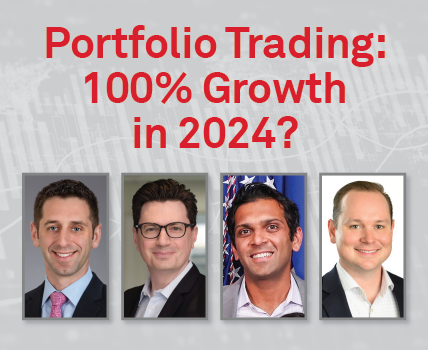Growing Use Cases, Sharper Pricing Propel Portfolio Trading Volumes
The stellar growth witnessed in portfolio trading (PT) in 2024 is here to stay as use cases evolve and execution matures, according to the panelists on a Coalition Greenwich webinar, Portfolio Trading: 100% Growth in 2024? The webinar was hosted by Coalition Greenwich Head of Market Structure & Technology Research Kevin McPartland.
“Portfolio trading has become a significant part of the market,” stated Paris Pender, Head of PT and Macro Credit Trading, Trumid. From 6% of TRACE in early 2023, the PT market ramped up to about 9% by year-end and is currently 10–11% of TRACE with average daily volumes (ADV) of $4.5 billion–$5 billion.
Rising Intramonth Flows
While PT “continues to be a staple of month-end” trading, owing to execution certainty and efficiency, the increase is primarily coming from intramonth flows. “Clients are increasingly comfortable using the protocol for flows, whether they’re ramping strategies up and down or engaging transitions,” said Pender.
“We’re doing it midweek… whenever the opportunity is there, we're able to interact with it,” stated Akash Goel, Head of Systematic Trading, Chicago Trading Company.
Until 2021, PT trading at Vanguard was largely month-end focused to rebalance the portfolio quickly and efficiently, said its Assistant Portfolio Manager Jake Riley. “That flow remains. But we are migrating more to the day-to-day—PT is in our toolbox now. Every time I'm evaluating a list, it's on the table.”
Expanding User Base
Growing electronification, improved data quality and the surge in investment from sell-side desks are all drawing the buy side to PT. The number of dealer participants has increased, and non-traditional liquidity providers have entered the market too.
“The more electronification happens, the better the workflows get, the more the adoption,” stated Goel.
Moreover, competitive pricing has become a big draw. “In micro-lot and odd-lot trades, PT is regularly cheaper than RFQ. A combination of user adoption and competitiveness has driven this. If anything, we expect more to come,” said Pender.
Improving Execution Quality
The availability of analytics, along with efficiency and execution certainty, are key reasons for the “migration of use cases to PT” at Vanguard, said Riley. As more participants go online, PT is also enabling ETFs to hedge risks more efficiently. “If you respond to an RFQ, you might win 25% of that. With PT, it is more direct. They [dealers] know they're going to win or not, and how they're going to hedge it or not. It's more seamless, which makes it a better experience for us on the buy side.”
Chicago Trading Company’s analysis of the effectiveness of sending bonds on a list versus PT showed that the PT “won out almost every time,” revealed Goel. “The idea that they can run a giant covariance, cross each other out and put the entire package in place [makes PT] the right avenue for it to go.”
Execution for the buy side has also improved because of pricing reliability and analytics tools on platforms like Trumid, which provides everything from a pricing model to sub-list analytics, and from pre-trade to “in-the-moment” tools.
Competition Compresses Covers
The growing competition is resulting in sharper pricing, too. According to Trumid, over the past three months, the covers have been about 3 cents on average, with around 33% of trades having a coverage of less than 1 cent.
“The space has gotten extraordinarily competitive, and it's held up in volatility as well,” stated Pender. Like it did this August, when “the yen story began to unravel.” On the days when the vol hit hard, the action in PT was very orderly. We saw clients selling at optical levels of 6–8 basis points from mid, but those were on-market levels, aggressive even, and not fire-sale prices. And then, very quickly, we saw dip buyers come in and execute trades in PT as well,” elaborated Pender.
A Mixed Bag
Is portfolio composition in PT changing to include, say, buy and sell, or investment-grade and high-yield bonds in the same basket?
According to Riley, “A lot more two-way flow in the same PT [is happening], whether it's people moving out the curve or trying to lock in higher yields.” Vanguard mixes buy and sell in the same basket to take advantage of rebalancing in funds. “We've found that has been pretty effective in being able to squeeze the outright risk profile of the overall basket to a lower cost.”
According to Goel, from a relative value basis, 70% of portfolio trades are directional, while the remaining 30% are mixed. “Often those directional ones line up well for certain relative value traders, then it doesn't. So, how do you recycle that flow back and forth? Those are some questions that the industry needs to figure out over the next year.”
Honing Up
Other areas will also get refined as the market matures. For instance, the market isn’t quite ready for an all-to-all framework, according to Pender.
“Over time, if there's better transparency, better electronification, more open competition, these things will continue to hone in,” stated Goel.

